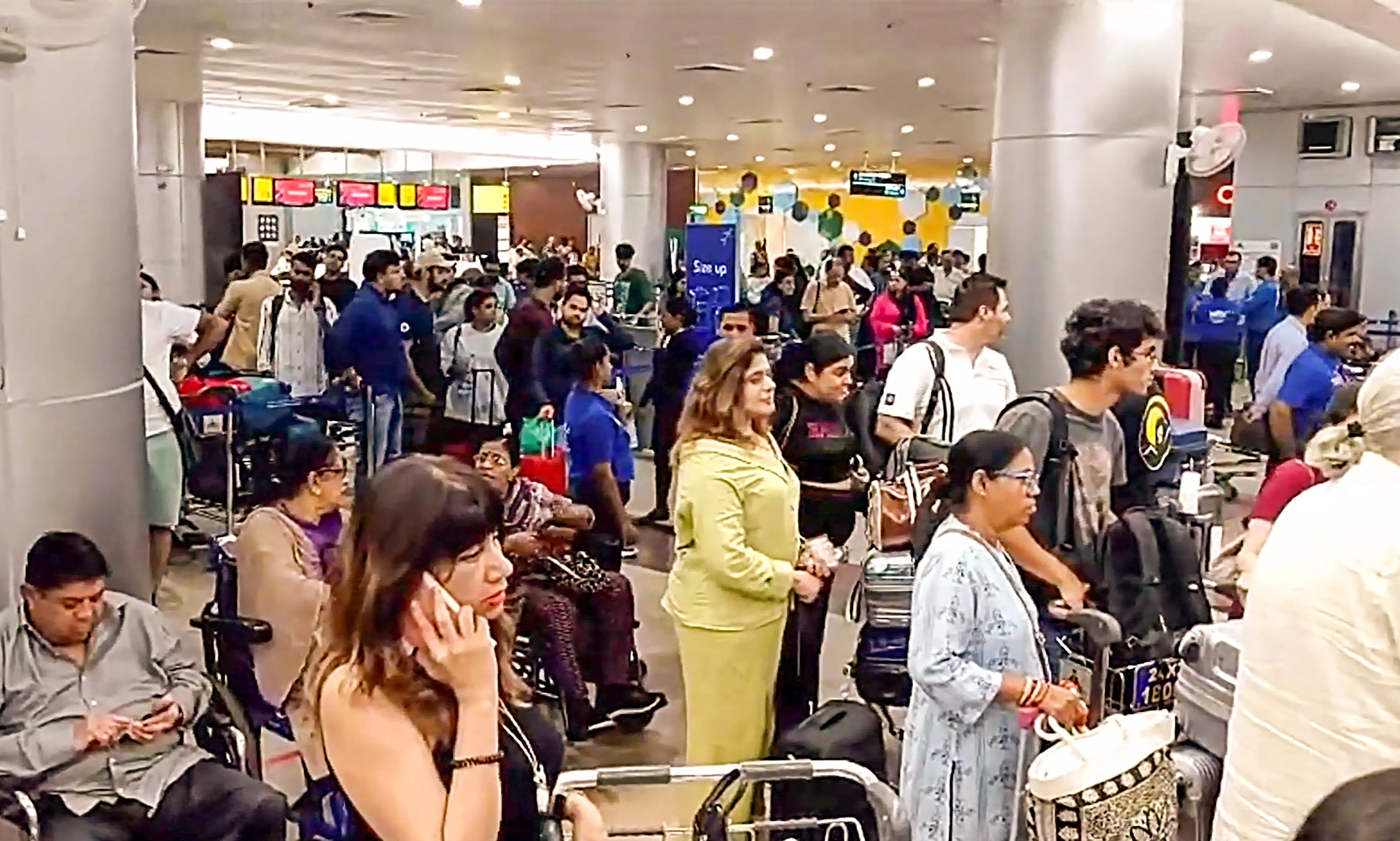
- Home
- India
- World
- Premium
- THE FEDERAL SPECIAL
- Analysis
- States
- Perspective
- Videos
- Sports
- Education
- Entertainment
- Elections
- Features
- Health
- Business
- Series
- In memoriam: Sheikh Mujibur Rahman
- Bishnoi's Men
- NEET TANGLE
- Economy Series
- Earth Day
- Kashmir’s Frozen Turbulence
- India@75
- The legend of Ramjanmabhoomi
- Liberalisation@30
- How to tame a dragon
- Celebrating biodiversity
- Farm Matters
- 50 days of solitude
- Bringing Migrants Home
- Budget 2020
- Jharkhand Votes
- The Federal Investigates
- The Federal Impact
- Vanishing Sand
- Gandhi @ 150
- Andhra Today
- Field report
- Operation Gulmarg
- Pandemic @1 Mn in India
- The Federal Year-End
- The Zero Year
- Science
- Brand studio
- Newsletter
- Elections 2024
- Events
- Home
- IndiaIndia
- World
- Analysis
- StatesStates
- PerspectivePerspective
- VideosVideos
- Sports
- Education
- Entertainment
- ElectionsElections
- Features
- Health
- BusinessBusiness
- Premium
- Loading...
Premium - Events

Repeated safety audits had warned that the runway-end area at Ahmedabad’s Sardar Patel International Airport was littered with debris, uneven surfaces and open drain holes
As investigators piece together the circumstances leading to the Ahmedabad air crash, it has brought back focus on a key area of aviation – the condition of Indian airports. What happened at Ahmedabad is a pointer to the grim situation that prevails at various airports in the country.
While India has made strides in airport development, particularly in regional connectivity, these are offset by gigantic infrastructure challenges that now stand in the way. Experts agree that Indian airports face significant infrastructure challenges, despite recent investments and developments. The key issues, which have been flagged repeatedly include inadequate capacity to handle increasing air traffic, leading to delays and congestion, and recurring problems with building maintenance.
Gross negligence
The deadly Ahmedabad crash is not about bad luck – it is about gross negligence. Sardar Vallabhbhai Patel International Airport has for long been deemed by experts to be among the most dangerously constricted airports, its runway extending into densely populated neighbourhoods in the city.
Also read | Ahmedabad crash: System failure or pilot error? Capt Ranganathan decodes
There are no buffer zones as well as no regular arrester system, which places limits on the margin for error. When the Boeing AI171 Dreamliner crashed into the quarters of the BJ Medical College this week, it just showed that an international airport was functioning with no protective zone between its airspace and the residential blocks.
Incidentally, this was no state secret. Repeated safety audits had warned that Ahmedabad’s runway-end area was littered with debris, uneven surfaces and open drain holes. A 2019 Directorate General of Civil Aviation (DGCA) report highlighted this anomaly. In 2018, the Airports Authority of India asked the Gujarat government for 29.79 acres of land to extend the runway’s safety area. The official approval came but not the land. The reason: it entailed removing 300 odd families, which could not be done as it was found to be politically inconvenient.
Plans for a parallel taxiway for relocation and cutting down congestion were all shelved in due course. The second promised airport at Dholera, announced in 2022 and advertised as the panacea to Ahmedabad’s congestion crisis, was meant to be operational in 2025, and continues to be a non-starter.
And this is happening in Prime Minister Narendra Modi’s ‘model’ state, represented by India’s most powerful politicians.
Compromising safety
Likewise, take Mumbai. With nearly 50 million passengers using the airport every year, issues need to be sorted out. For instance, the expansion of the runway cannot be undertaken because of squatters who need to be humanly rehabilitated and moved out from a highly risky area. But that can only happen when all stakeholders are on board.
S Mangala, a former Air Traffic Controller (ATC) and Air Safety Officer with the Airports Authority of India (AAI), became a whistleblower, raising concerns about flight safety violations and building height restrictions near Mumbai Airport.
She filed a criminal Public Interest Litigation (PIL) and intervened in a Bombay High Court PIL related to air safety. Earlier, in a report compiled by her, while in service, told the whole story.
Encroaching airspace
“The encroachment of airspace by the buildings around the airports is cancer spreading across Indian airports, but it has brought aviation safety to critical limits in Mumbai. There is the involvement of top officials of the MIAPL [Mumbai International Airport Private Limited], the AAI, DGCA and the MoCA [Ministry of Civil Aviation] in compromising aviation safety and therefore I recommend that the mitigation measures recommended in this report be undertaken under the supervision of ICAO [International Civil Aviation Organisation],” said the ‘Report on Aviation Safety’ authored by her.
“The unwillingness of the authorities to act in accordance with air regulations could be catastrophic in case of any eventuality because the number of ground casualties could be far more than that of passengers and crew put together,” it added.
Some of it did find resonance in Ahmedabad with the death of medics on the ground. Protected by powerful political interests, encroachers and illegal settlers – who may never hope to fly in an aircraft – refuse to move out endangering countless lives.
Crumbling infrastructure
Now, consider the following:
In June 2024, a partial roof collapse occurred at Delhi airport’s Terminal-1 (T1) during heavy rains, resulting in one fatality and six injuries. Such incidents are not uncommon at Indian airports, where the quality of infrastructure has long been scrutinised due to mishaps during severe weather. Despite government efforts, concerns persist about the construction and materials used, raising questions about airport infrastructure management.
Also read | Ahmedabad crash: Insurance claims payout could run up to Rs 2,400 Crore, say experts
In May last year, Bengaluru experienced significant disruption due to heavy rainfall leading to severe waterlogging and air travel disruptions. The Kempegowda International Airport, commonly known as Bengaluru Airport or BLR Airport, was flooded prompting the diversion of at least 17 flights to Chennai.
Earlier in March, during heavy rainfall, a section of the roof at Guwahati’s Lokpriya Gopinath Bordoloi International Airport collapsed. It caused water to flow inside, creating chaos at the airport. No injuries were reported.
Due to Cyclone Michaung in December 2023, the Chennai airport runway was flooded affecting flight operations.
In July 2023, Ahmedabad's Sardar Vallabhbhai Patel Airport faced severe flooding following continuous rainfall. Numerous social media users shared videos depicting the airport submerged in knee-high water, showing runways and terminal areas inundated.
Global aviation power
Such petty infrastructural bottlenecks don’t do justice to India’s standing as a global aviation power. According to a report from the India Brand Equity Foundation, India's civil aviation sector has shown remarkable growth, becoming one of the fastest-growing industries in the country. The country ranks as the world’s third-largest domestic aviation market behind the US and China. With a market size of US$ 16 billion, India currently stands as the tenth-largest civilian aviation market.
On June 14, The Indian Express reported that India was rated well above the global average in terms of its operations and airworthiness by the ICAO when the DGCA was last audited in November 2022, with the overall Effective Implementation score being raised to 85.65 per cent from 69.95 per cent in 2018, indicating an improvement in the country’s aviation safety ranking.
Clearly, this graph needs to be maintained.
Safety downgrade
Equally significant, India has been warned in the past. In January 2014, the US Federal Aviation Administration (FAA) downgraded India's civil aviation safety rating to Category II, citing significant safety oversights by the DGCA. This downgrade meant that Indian airlines faced restrictions on expanding flights to the US and were subjected to additional scrutiny on existing routes. The FAA's decision was based on the findings of two audits conducted in 2013, which highlighted deficiencies in India's aviation safety oversight and a lack of infrastructure and manpower at the DGCA.
The downgrade placed India in the same category as countries like Nicaragua, Serbia, and Ghana, indicating a failure to meet international safety standards. As a result, Indian airlines, particularly Air India and Jet Airways, were prohibited from increasing flights to the US and faced increased inspections on their existing US routes. The FAA also indicated that Indian carriers would need to cut code-sharing agreements with US airlines.
The downgrade prompted the Indian government to address the concerns raised by the FAA. The DGCA committed to resolving the identified issues and expressed hope that the FAA would review the decision. The US FAA ultimately upgraded India’s aviation safety ranking back to Category I in April 2015 after India demonstrated corrective actions.
In the past, ICAO audited India’s civil aviation sector and discovered severe safety lapses. One specific audit, potentially in 2016, highlighted issues, including the allegation of collusion between bureaucrats and aviation officials, potentially endangering air safety.
Air India crash probe
The probe into the Ahmedabad Air India plane crash is being undertaken by the Aircraft Accident Investigation Bureau (AAIB), with the investigation to be done in line with protocols set by the ICAO.
Also read | How Boeing 787 Dreamliner became a game-changer for long-haul flights
Aiding the process will be the US National Transportation Safety Board, considering that the aircraft that came down was an American product, Boeing. The UK’s Air Accidents Investigation Branch will also have expert status in the safety investigation on account of the British citizens being on board the aircraft. In addition to these national agencies, Boeing and aircraft engine manufacturer GE are also expected to help in the investigation and provide information about the aircraft, as required by the ICAO’s protocols.
For all that we can predict, these multi-agency-driven probes may well throw up startling conclusions.
(The Federal seeks to present views and opinions from all sides of the spectrum. The information, ideas or opinions in the articles are of the author and do not necessarily reflect the views of The Federal.)


